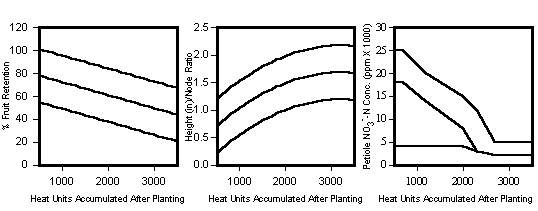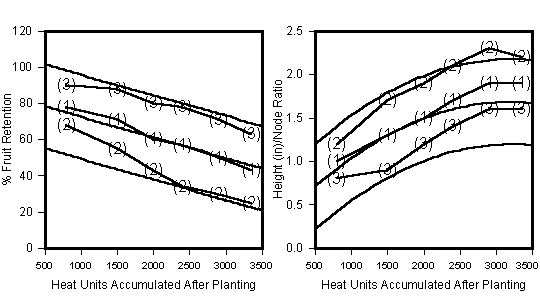Feedback Requirements for Nitrogen Management
(Publication az1201)
(PDF version, 35KB)
by Jeffrey C. Silvertooth,
Extension Agronomist - Cotton
The utilization of a feedback approach requires a systematic approach to soil and crop monitoring. Accordingly, there are some basic requirements associated with a feedback approach per se. The following information provides an outline of a feedback approach to N management in an irrigated cotton production system.
Feedback Management Requirements
- Useable/accessible measurements
- Established baselines/guidelines
- Reference base
- Common variety types (species)
- Regionally specific baselines
- Validation of recommendations
Estimation Total N Needs
- Use realistic yield goal
- Use approximately 60 lbs. N/bale of lint/acre
- Subtract residual soil NO3--N present in irrigation water
- Split applications in-season in approximately 40 to 70 lbs. N/acre increments
Crop Monitoring - N Management
- Crop vigor estimate
- Height to node ratios (HNRs - refer to baselines)
- Fruit retention (plant mapping)
- High fruit load = high N demand
- N fertility status
- Petiole NO3--N guidelines


Begin fertilizer N applications at or just prior to the first post-plant irrigation, which should occur near the time when the first squares are appearing on the plant. Proceed with additional split applications, dependant upon plant conditions, and complete fertilizer application by peak bloom.
Case 1
- High fruit load (high fruit retention)
- HNR within thresholds (perhaps low)
- N input needed
- Decline on petiole NO3--N levels
- Provide application of N fertilizer
- PIXTM not needed
Case 2
- Low fruit load (low fruit retention)
- HNR is high (relative to guidelines)
- Hold back or reduce N fertilizer inputs
- Consider PIXTM application
Case 3
- HNR is low (relative to guidelines)
- Maintain N fertilizer inputs
- PIXTM not needed
- Crop is experiencing some form of stress
- Water, N, salinity, etc.
- Limiting growth
- Identify and correct
Issued in furtherance of Cooperative Extension work, acts of May 8 and June 30, 1914, in cooperation with the U.S. Department of Agriculture, James A. Christenson, Director Cooperative Extension, College of Agriculture and Life Sciences, The University of Arizona.
The University of Arizona is an equal opportunity, affirmative action institution. The University does not discriminate on the basis of race, color, religion, sex, national origin, age, disability, veteran status, or sexual orientation in its programs and activities.
Any products, services, or organizations that are
mentioned, shown, or indirectly implied in this web document do not imply
endorsement by The University of Arizona.
Information provided by Jeffrey C. Silvertooth, silver@ag.arizona.edu
Extension Agronomist - Cotton, College of Agriculture, The University of Arizona.
Material written February 2001.
Home | Cotton | Advisories
document located at: http://cals.arizona.edu/crops/cotton/soilmgt/feedback_nitrogen_management.html
Copyright © 2001 University of Arizona,
College of Agriculture and Life Sciences
Webmaster: Al Fournier (acis@ag.arizona.edu)